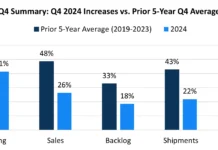by Joellen Sorenson, director
Stout

The satisfaction of succeeding as a business owner can be unparalleled – achieving millions in sales by starting with an idea and a plan, weathering ups and downs and giving dozens, hundreds or even thousands of employees a chance to earn a living. Inevitably, there will come a time when change is necessary, and one of the most important decisions a business owner will face is how to address a major ownership transition.
In response to a growing number of members seeking advice in this area, a panel of plastics business owners/operators shared their stories as part of the inaugural Executive and Owners Track at the annual MAPP Benchmarking and Best Practices Conference in Indianapolis, Indiana, in October.
Mike Benson, an incoming MAPP board member and managing director in Stout’s Investment Banking group, moderated an insightful and candid discussion before an audience of more than 100 executives.
Benson was joined by the following:
- Thomas Duffey – former president, Plastic Components (PCI)
- Kelly Goodsel – president, Viking Plastics
- Bob MacIntosh – president and CEO, Nicolet Plastics
- Jim Rikkers – managing director, Spell Capital Partners
Benson began the conversation with the following remarks: “The current strong performance of the industry, coupled with an overall sustained, robust economy, has fueled a dynamic merger and acquisition (M&A) environment among plastics companies. Executing a transaction often is a once-in-a-lifetime experience, and it can vary greatly from one business to the next. Fortunately, there are steps you can take now to prepare your business, enable a smooth process and ensure the best possible results. One of those steps is to hear real stories from real business owners about their personal experiences navigating and succeeding at selling their businesses.”
The panelists acknowledged the unique circumstances and objectives behind a business owner’s decision to pursue a transaction or liquidity event.
Goodsel, Viking Plastics, wanted to grow the business, both organically and through acquisition. However, the company lacked cash to pursue the acquisitions, and Goodsel was reluctant to take on significant debt given his current life stage – not ready to retire, but not ready to step away from the business, either. Ultimately, the decision was made to pursue acquisition growth with a partner.
Duffey, PCI, had been in the business a long time and was ready to step away. “I had a deep, emotional investment in my company’s efforts, but I could feel my tank was running dry, both physically and spiritually.” From the time he made the decision, the process still took two-and-a-half years to reach conclusion.
MacIntosh, Nicolet Plastics, was motivated by succession planning. He had started buying out his partners in 2000 and subsequently began to contemplate his own future. He communicated with employees early about how a transaction might impact the company and his goals for protecting them. Around the same time, MacIntosh received a call from a representative of a longtime family-owned company in Wisconsin looking to diversify its assets. It turned out to be the perfect fit.
Two of three owners on the panel sold to a private equity (PE) firm as their new partners. They discussed what differences, if any, they viewed between selling to a PE firm rather than a strategic buyer.
Goodsel had the unique experience of trying to sell the company three times. When the first two didn’t work out, the third time was a charm – Viking Plastics connected with Spell Capital and completed the transaction. Goodsel indicated the relationship with Spell Capital has been extremely positive. “They’ve executed as they said they would and with great confidence in the business. A strong management team is in place, and an acquisition has been completed. With a PE buyer, I still have significant ownership but not control. It’s been great.
Duffey involved his management team to a great extent. They took the process very seriously and carefully considered their options after every management presentation. They also relied on guidance from their financial adviser, Benson. “We were deliberate in our process,” Duffey said, “but at no point in the cycle did we make a decision about going with a specific type of partner – either a PE buyer or a hybrid.”
Offering additional insight was Rikkers, who discussed why Spell Capital, and PE investors in general, find the plastics industry attractive and what plastics businesses can do to attract investors.
Rikkers said the industry is significant in size and has specific dynamics that draw attention from PE investors looking for opportunity. Most notably, a small number of companies control the top of the market, with a great deal of fragmentation below that. “Fragmentation creates opportunity to try to help owners go through these types of transitions and also consolidate to better compete with the larger companies.”
Typically, Spell Capital starts by looking at the fundamentals of the business: financial performance (including audited financial statements), growth plans and strength of the management. A big emphasis is placed on management continuity – whether there’s a plan in place to continue to manage the business after they invest. “We’re looking for profitable, well-run businesses, and the last thing we want to do is change that.”
Diversity in the customer base and end markets, along with strong supplier relationships also were identified as desirable, value-adding attributes for investors. “If a company is in a niche business, we really strive to understand the specialty – what is the company’s ‘reason for being’?”
Benson asked the owners/operators whether there was anything they would have done differently to better prepare for the process of selling.
The panel agreed unanimously that they wished they had started sooner: They had underestimated the number of hours they would invest in the process and also acknowledged how critical it is to have a strong team of advisers.
Goodsel said, “Start sooner, expect more hours and adopt a mindset that you’re selling your business tomorrow. This will motivate you to start addressing all of the things (Rikkers) mentioned. The process puts huge demands on your time that you just can’t plan for. The earlier you get yourself in order, the easier it will be.
Duffey cited corporate governance as an area that required tremendous focus. “I should have had a board of directors that included a few people who knew how to prepare for and execute transactions.” He used the analogy of a nine-inning baseball game and suggested enlisting knowledgeable advisers to help guide companies to the third or fourth inning before deciding whether to proceed. “You need to build the (sale) mentality into your business. Then establish a board that will hold your feet firm, and discuss your progress toward this goal at every meeting.”
MacIntosh belonged to a CEO networking group with people experienced in M&A. Despite the advice he received from this group, he mentioned that one area of improvement for him could have been better tax planning, as he’s anticipating writing a large check to the government come April.
Rikkers also offered sage advice. “Tactically, in addition to the strategic things, have the right advisers – an accountant, an attorney and an M&A adviser. These professionals are paramount in making transactions go as smooth as possible. When you’re faced with the difficult discussions, the expert third parties help guide you in decision making.
Benson shifted the discussion to when and how to share the news of a transaction with employees and customers.
Goodsel addressed the difficulties of this process, saying “It’s not something that’s easily managed.” He suggested that companies’ CFOs will need to know of a potential sale early and be heavily involved, with the rest of the management team following from there. He did not communicate with his plant until a week after the transaction was complete, appealing to their good senses to not share the news until they could properly notify customers. “Customers are the lifeline of your business, so you don’t want to spook them.”
Duffey involved five people from his management team, a few of whom had been through a sale before, which was helpful. But overall, he kept it a tight subject. When it came to telling customers, Duffey said it didnt go as smoothly as he would have liked. “Customers weren’t as effusively positive as I was hoping, and some used the situation as a window of opportunity to play hardball in a way I wasn’t comfortable with.”
MacIntosh, when Nicolet Plastics was near the end of its transaction, met personally with his top 10 customers. He let them know his team was looking at a succession plan, gave them some comfort on who the buyer might be and explained none of their contacts would change.
Benson concluded the discussion by asking the panel for parting comments or final advice to share.
Duffey addressed the importance of resources. “All of us in this room are very fortunate that we have resources within the MAPP community – attorneys, accountants, investment banking professionals – to draw on. If you don’t take advantage of these relationships through the MAPP universe, youre doing yourself a disservice.”
Goodsel touched on the familial aspects of a business. “Think about it this way: You have a great company with a lot of great employees. You also have a family you care about. If and when you sell your business, you’re going to fight tooth and nail. If you haven’t planned what you’re going to do with that business, then your company, your employees and your family aren’t being served.”
For additional information, contact Stout at 773.750.7150 or visit www.stoutadvisory.com.




